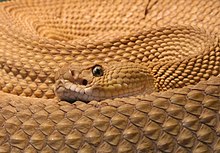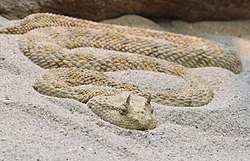Viper
| Vipers | |
|---|---|

| |
| Mexican west coast rattlesnake, Crotalus basiliscus | |
| Scientific classification | |
| Kingdom: | |
| Subphylum: | |
| Class: | |
| Order: | |
| Suborder: | |
| Family: | Viperidae |

Vipers are a family of venomous snakes, the Viperidae. All have long, hinged fangs that dig deep into their prey and inject venom. The venom causes internal bleeding. There are four subfamilies of the Viperidae.
Description
[change | change source]All vipers have a pair of long hollow fangs which are used to inject venom from glands found in the back of the upper jaws. The venom is a kind of protease, a destroyer of protein.
Almost all vipers have ridged scales, a well built body with a short tail and, to make room for the venom glands, a triangular-shaped head. Their slit-shaped pupils can open wide to open most of the eye, or close almost completely. This helps them to see in a wide range of light levels. Vipers are nocturnal, meaning that they sleep in the day and wake up at night to go hunting.
Like other snakes, vipers are predators, meaning that they eat other animals. Their main diet is birds (including bird eggs), amphibians, such as frogs and toads, and other small reptiles like lizards and smaller snakes.
Reproduction
[change | change source]Most viper species are ovoviviparous, giving birth to live young, but a few lay eggs. The word "viper" is derived from Latin vivo = "I live" and pario = "I give birth".[2]
Where they live
[change | change source]Viper snakes are found in Americas, Africa, Eurasia. In the Americas they live from southern Canada, through the United States, Mexico, Central America, and into South America. The only type of viper which lives in the United Kingdom are the adders.
Subfamilies
[change | change source]| Subfamily[3] | Taxon author[3] | Genera[3] | Species[3] | Common name | Geographic range[1] |
|---|---|---|---|---|---|
| Azemiopinae | Liem, Marx & Rabb, 1971 | 1 | 1 | Fea's viper | Myanmar, southeastern Tibet across southern China (Fujien, Guangxi, Jiangxi, Kweichow, Sichuan, Yunnan, Zhejiang) to northern Vietnam. |
| Causinae | Cope, 1859 | 1 | 6 | Night adders | Subsaharan Africa |
| Crotalinae | Oppel, 1811 | 18 | 151 | Pit vipers | In the Old World from eastern Europe eastward through Asia to Japan, Taiwan, Indonesia, peninsular India and Sri Lanka. In the New World from southern Canada southward through Mexico and Central America to southern South America. |
| Viperinae | Oppel, 1811 | 12 | 66 | True or pitless vipers | Europe, Asia and Africa. |
Type genus = Vipera—Laurenti, 1768[1]
References
[change | change source]- ↑ 1.0 1.1 1.2 McDiarmid RW, Campbell JA, Touré T. 1999. Snake species of the world: a taxonomic and geographic reference. vol. 1. Herpetologists' League. ISBN 1-893777-00-6 (series). ISBN 1-893777-01-4 (volume).
- ↑ Schuett GW et al 2002. Biology of the Vipers. Eagle Mountain Publishing LC. ISBN 0-9720154-0-X.
- ↑ 3.0 3.1 3.2 3.3 "Viperidae". Integrated Taxonomic Information System. Retrieved 10 August 2006.
